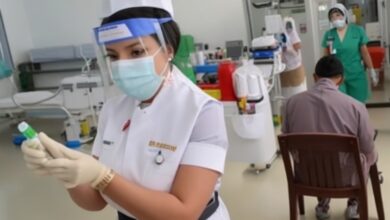Infection Control Protocols in Nursing Practice

Table of Contents
Introduction
Ah, the lifeline of hospitals – nurses. More than just care providers, they’re the sentinels keeping harmful infections at bay. Ever wondered how they achieve this? The answer lies in intricate infection control protocols. Dive with us into this world and see how nurses don their invisible armor against infections.
Understanding the Basics
At its heart, an infection is an unwanted party crasher. Tiny microorganisms – bacteria, viruses, fungi – that can cause diseases. These sneaky invaders are everywhere, from the doorknob you just touched to the very air you breathe. And in hospitals, the stakes are even higher. It’s a battleground where nurses are the frontline warriors, ensuring these microscopic foes don’t claim victory.
To demystify infections, let’s zoom into their world for a moment. There are billions of bacteria around us, many beneficial, and some that cause diseases known as pathogens. Then there are viruses, much tinier than bacteria, causing everything from the common cold to more serious diseases. Add fungi to the mix, which can lead to conditions like athlete’s foot or more severe infections in people with compromised immune systems. In a healthcare setting, the presence of these pathogens is like a ticking time bomb, and nurses are the bomb squad, trained to diffuse the situation before it explodes.
The Principles of Infection Control
Imagine a row of dominos, each knocking the next one down. That’s the chain of infection for you. And the goal? Break that chain. Nurses are trained to identify and target every link in this chain – be it the source of the infection or the route it takes. Stopping the domino effect can mean the difference between health and illness.
When we talk about the chain of infection, think of it as a relay race where the baton, in this case, the pathogen, is passed from one point to another. Here’s where it gets interesting: if we can trip up even one runner (or link), the whole race falls apart. For nurses, understanding this chain means they can strategically intervene, making sure that baton never reaches its finish line.
Standard Precautions in Nursing Practice
You’ve heard the saying, “Clean hands save lives.” It’s the golden rule in nursing. Hand hygiene is the first line of defense. But there’s more. Donning gloves, masks, and gowns, nurses equip themselves like knights going into battle. It’s all about minimizing contact with harmful pathogens. A simple cough or sneeze? Even these everyday actions have etiquette in place to prevent the spread of germs.
Imagine gearing up for a day where every surface, every hand you shake, could be a potential hazard. In this world, the simple act of washing hands becomes an art. Nurses not only master this art but also use protective equipment like a seasoned warrior. They’re the guardians at the gates, ensuring no pathogen gets through on their watch. Masks filter the air they breathe, gloves act as barriers, and gowns shield them, ensuring they remain the unyielding protectors of health.
Transmission-Based Precautions
But wait, sometimes the standard defenses just don’t cut it. For those extra crafty pathogens, nurses have a special set of tactics up their sleeves. Depending on whether the unwanted guest travels through air, droplets, or direct contact, specific precautions kick in. It’s like having an extra set of locks on a treasure chest.
Let’s get into the nitty-gritty. Some pathogens are airborne, traveling like whispers. Others hitch a ride in droplets, like when someone sneezes. Then there are those that require direct contact, moving from person to person through touch. For nurses, each type of invader requires a specific game plan. It’s not just about defense but about knowing the enemy and tailoring strategies accordingly.
Environmental Control
Imagine walking into a pristine room, surfaces gleaming and air fresh. It’s no accident. Regular cleaning rituals ensure that every nook and cranny is free from potential threats. From using the right disinfectants to handling waste with care, maintaining a clean environment is paramount in the fight against infections.
A hospital room isn’t just a room. It’s a sanctuary, a place where health is restored. Ensuring this sanctuary remains uncontaminated is no small feat. Beyond the visible cleanliness, there’s a world of protocols ensuring that everything from bed linens to surgical instruments remains sterile. For nurses, this environment is both their workplace and their charge, and they defend its sanctity with dedication.
Nursing Practices that Reduce Risk
Here’s where the expertise of a nurse truly shines. Using aseptic techniques ensures that even invasive procedures like injections remain safe. And for those particularly contagious cases? Isolation nursing comes into play, ensuring that infections remain contained.
In the vast toolkit of a nurse, techniques like asepsis stand out. It’s the practice of making sure no pathogens are introduced to vulnerable areas – think surgeries or open wounds. Then there’s isolation nursing, a specialized approach for patients who have infections that could spread easily. It’s like putting a protective bubble around the patient, ensuring their condition doesn’t affect others.
Infection Control in Special Situations
Caring for a neonate is vastly different from tending to an adult. Different patients, different protocols. Each scenario has its unique challenges, and nurses are adept at tailoring their approach. Whether it’s in the bustling environment of an ICU or the quiet comfort of home care, infection control remains paramount.
Every patient is unique. A child might not understand why they can’t leave their room, or why their nurse is wearing a mask. In these situations, nurses combine their medical knowledge with a hefty dose of compassion and creativity. Adapting to the unique needs of each scenario, they ensure that safety and comfort go hand in hand.
The Role of Education and Training
Knowledge is power. Regular training ensures that nurses stay one step ahead of the ever-evolving world of pathogens. And it’s not just about their safety. Educating patients is a crucial part of the puzzle. After all, awareness can be a potent weapon against infections.
In the ever-evolving world of medicine, staying updated is not a luxury but a necessity. Regular workshops, seminars, and courses ensure that nurses are equipped with the latest knowledge. But their role as educators extends beyond their community. By educating patients and their families, they empower them, turning them into allies in the fight against infections.
Challenges in Implementing Infection Control
In an ideal world, every protocol would be followed to the T. But real-world scenarios bring their own set of challenges. Whether it’s a resource crunch or simple human error, nurses often have to think on their feet. Adapting and overcoming, they ensure safety remains uncompromised.
The road to impeccable infection control isn’t always smooth. Despite the best intentions, nurses often face hurdles. Picture this: a packed ER on a busy night with limited resources, or a power outage that hinders sterilization processes. It could even be as simple yet complex as ensuring all hospital staff comply with hand hygiene protocols every single time. These challenges test the resilience and adaptability of nurses. Through quick thinking and resourcefulness, they find ways to stay ahead, ensuring the safety of both themselves and their patients.
Monitoring and Accountability
What gets measured, gets managed. Regular audits, feedback loops, and assessments ensure that infection control protocols aren’t just on paper. It’s a cycle of continuous improvement, ensuring that the highest standards are always met.
You can’t manage what you don’t measure. In the world of infection control, this adage is paramount. Regular checks and audits ensure that standards are not just met but consistently upheld. The introduction of electronic health records (EHRs) has revolutionized how compliance is tracked. But technology is just one part of the puzzle. Feedback from peers, patients, and interdisciplinary teams ensures that the nursing practice continually evolves, striving for excellence.
The Future of Infection Control in Nursing
With tech advancements, the tools at a nurse’s disposal are ever-evolving. From electronic health records to smart monitors that track hygiene practices, the future looks promising. But technology aside, the human touch remains irreplaceable.
Change is the only constant, and in healthcare, it’s rapid. As we step into the future, technology offers new promises in infection control. Drones delivering sterilized medical supplies, smartwatches reminding healthcare professionals about hand hygiene, or AI-powered surveillance systems monitoring and predicting infection outbreaks— the horizon is exciting. But amidst all this tech, one thing remains unwavering: the commitment of nurses. Their blend of compassion and expertise ensures that patients receive not just medical care, but holistic healing.
Conclusion
As we pull back the curtains on the world of infection control in nursing, one thing is clear. It’s a dance of science and art, protocols, and intuition. And leading the charge? Our indomitable nurses, ensuring that health isn’t compromised.
As we journey through the intricacies of infection control in nursing practice, one thread remains consistent: the unwavering commitment of nurses. They stand as the guardians at the threshold, ensuring that pathogens don’t get the upper hand. It’s a blend of art and science, protocol, and intuition. In a world teeming with invisible threats, the dedication of nurses ensures that we can all rest a little easier, knowing that they’re always on guard, always vigilant.




